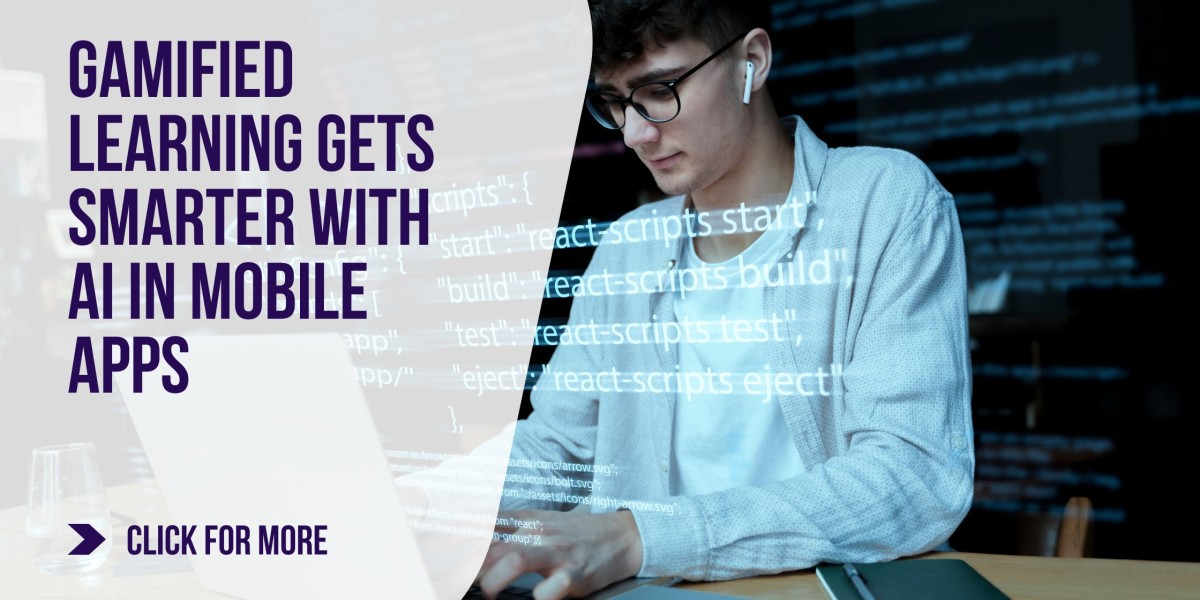If you think gamified learning is just about turning lessons into colorful quizzes or fun points-based challenges, think again. The landscape of gamification in education is undergoing a subtle but significant revolution, powered by artificial intelligence (AI). What used to be a one-size-fits-all approach is now evolving into a highly personalized, adaptive, and engaging experience—right on your mobile device.
The fusion of AI and gamified learning is not hype; it’s reshaping how we learn by making education smarter, more accessible, and surprisingly effective. If you’re curious about what’s really going on behind the scenes in the mobile apps your kids—or you—might be using, this deep dive will open your eyes. You’ll see how mobile app development is pushing boundaries to make learning feel less like a chore and more like an engaging adventure.
The Rise of Gamified Learning: More Than Just Fun and Games
Gamified learning isn’t a new concept. For years, educators have tapped into the motivational power of games—levels, badges, leaderboards—to make learning more attractive. But the challenge has always been maintaining engagement without sacrificing educational value. Many early gamified apps ended up as gimmicks, offering surface-level fun without truly adapting to learners' needs.
Now, AI is changing the equation. Instead of a fixed structure, gamified learning environments can respond intelligently to how a learner performs, what they struggle with, and even how they feel. This is a big shift. The result is a learning experience that is not only entertaining but also tailored for maximum impact.
How AI Transforms Gamification in Mobile Learning
At its core, AI enhances gamification by making it smarter. Here’s how:
Personalized Learning Paths: AI analyzes individual progress and dynamically adjusts challenges, content, and rewards to fit each learner’s strengths and weaknesses. No more one-size-fits-all; every player has a unique journey.
Adaptive Difficulty: Instead of frustrating users with tasks that are too hard or boring them with tasks that are too easy, AI modulates game difficulty in real-time, keeping learners in a state of “flow” where learning feels natural and rewarding.
Behavioral Analytics: AI tools monitor how learners interact with the app, identifying patterns such as when motivation drops or which types of activities resonate best, then tweaking the experience to keep engagement high.
Natural Language Processing (NLP): This allows AI to interpret learners’ responses, offer hints, and provide conversational feedback that feels human and supportive rather than mechanical.
Emotional Recognition: Some advanced AI systems can even detect frustration or excitement through voice or facial recognition (with user permission), adjusting gameplay or offering encouragement accordingly.
These features elevate gamified apps from simple quizzes into dynamic, responsive learning environments.
The Science Behind Smarter Gamified Learning
The effectiveness of AI-powered gamification is not just theoretical. Cognitive science and educational psychology back the approach:
Immediate Feedback: AI provides instant feedback, which is known to enhance learning retention and correct mistakes before they become habits.
Reinforcement Learning Principles: Gamified apps use rewards strategically to reinforce positive learning behaviors, leveraging dopamine-driven motivation pathways in the brain.
Spaced Repetition: AI schedules challenges and reviews at optimal intervals to strengthen memory and skill acquisition, adapting this spacing individually.
Multi-Sensory Engagement: By combining visuals, sounds, and interactive elements, gamified apps cater to various learning styles, helping reinforce concepts more deeply.
This blend of science and technology makes AI-driven gamification a powerful learning tool, especially for mobile users on the go.
Real-World Success Stories: AI and Gamified Learning in Action
Several educational platforms are already showing the real impact of combining AI with gamification:
Duolingo: This language learning app uses AI to personalize lessons, monitor user progress, and adjust the difficulty of exercises, all wrapped in a game-like interface with streaks and rewards that motivate daily practice.
Kahoot! While known for live quizzes, Kahoot! has begun integrating AI-driven analytics to tailor content recommendations based on class performance, making gamified learning more effective at scale.
Prodigy Math Game: Tailored for children struggling with math, Prodigy uses AI to identify gaps in understanding and crafts personalized quests that help students learn without feeling pressured.
Smart Sparrow: This adaptive e-learning platform incorporates gamified elements and AI to create interactive lessons that adjust in real time, improving engagement and learning outcomes.
What these examples show is that gamified AI apps are not just entertainment—they are serious educational tools that respect the complexity of learning.
Challenges in Developing AI-Powered Gamified Learning Apps
Of course, creating these apps is not without hurdles. The intersection of gaming, AI, and education presents unique challenges:
Balancing Fun and Learning: Developers must avoid turning apps into games with minimal educational value. The challenge is designing experiences that genuinely teach while remaining engaging.
Data Privacy and Ethics: Collecting detailed behavioral data requires transparent policies and stringent safeguards to protect users, especially minors.
Avoiding Over-Reliance on Gamification: Some learners may become more focused on rewards than mastering skills, so apps need to balance extrinsic and intrinsic motivation.
Technical Complexity: Integrating AI that adapts smoothly in real time demands advanced algorithms and thorough testing.
Addressing these challenges requires collaboration among educators, AI specialists, and game designers to ensure apps are both effective and responsible.
What Learners Gain: The User Experience Advantage
For users, AI-powered gamified learning apps offer a fresh and empowering experience:
Engagement: Learning doesn’t feel like a drag. Instead, learners look forward to their next challenge, driven by curiosity and tailored rewards.
Confidence: Personalized support helps users overcome difficulties without frustration, making progress visible and attainable.
Flexibility: Mobile delivery means learning can happen anytime, anywhere—whether it’s a few minutes waiting for the bus or a focused study session at home.
Autonomy: Adaptive paths give learners control over their journey, fostering independence and self-motivation.
This user-centric approach redefines what education apps can achieve.
The Role of Educators in the Age of AI Gamification
Educators are not sidelined by these technological advances. On the contrary, AI-powered gamified apps provide teachers with valuable tools and insights.
Real-time analytics help teachers understand individual and group performance, identify struggling students, and tailor classroom activities accordingly.
Moreover, these apps free up time by automating routine assessments, allowing educators to focus on mentorship and creative instruction.
Successful integration depends on training teachers to use these tools effectively and ensuring apps complement—not replace—traditional teaching.
The Future: AI, Gamification, and Mobile Learning
Looking ahead, the synergy of AI and gamified learning on mobile platforms is poised for exciting developments:
Deeper Personalization: Future apps may integrate biometric data (heart rate, attention levels) to fine-tune challenges even further.
Social Learning: Enhanced multiplayer features and AI-moderated peer collaboration can add social motivation and shared problem-solving.
Cross-Disciplinary Learning: AI can craft gamified experiences that span subjects, connecting skills in math, language, and science through story-driven gameplay.
Virtual and Augmented Reality: Combining AI with immersive tech will make gamified learning environments even more engaging and realistic.
As the technology matures, mobile app developers have a unique opportunity to create the next generation of educational apps that truly transform learning.
Why Mobile App Development Services Should Embrace AI Gamification
For developers and businesses, investing in AI-powered gamified learning apps makes sense beyond the social good:
Market Demand: Parents, schools, and learners are actively seeking engaging, effective educational tools.
Competitive Edge: AI integration distinguishes apps in a crowded marketplace.
Long-Term User Retention: Adaptive learning paths keep users engaged longer, increasing app loyalty.
Data Insights: Developers can refine products through detailed user analytics, improving experiences continuously.
However, this requires commitment to quality AI development, user privacy, and collaboration with education experts.
Conclusion: The Smarter Playbook for Learning Is in Your Pocket
Gamified learning has come a long way from simple quizzes and badges. With AI embedded in mobile apps, the experience is smarter, more personalized, and far more effective. Learners no longer have to endure one-size-fits-all content; instead, they engage in adaptive challenges that respect their pace and style, backed by real-time feedback and motivation.
This evolution is reshaping education globally, making learning accessible, engaging, and impactful for diverse audiences.
If you’re exploring mobile solutions that harness this potential, keep in mind that expert AI integration and thoughtful design are key. The growing landscape of app development Atlanta is one such hub where innovation meets education, paving the way for the future of gamified learning.
The future of education is not just in classrooms—it’s in the palms of our hands, playing smarter, learning better.








